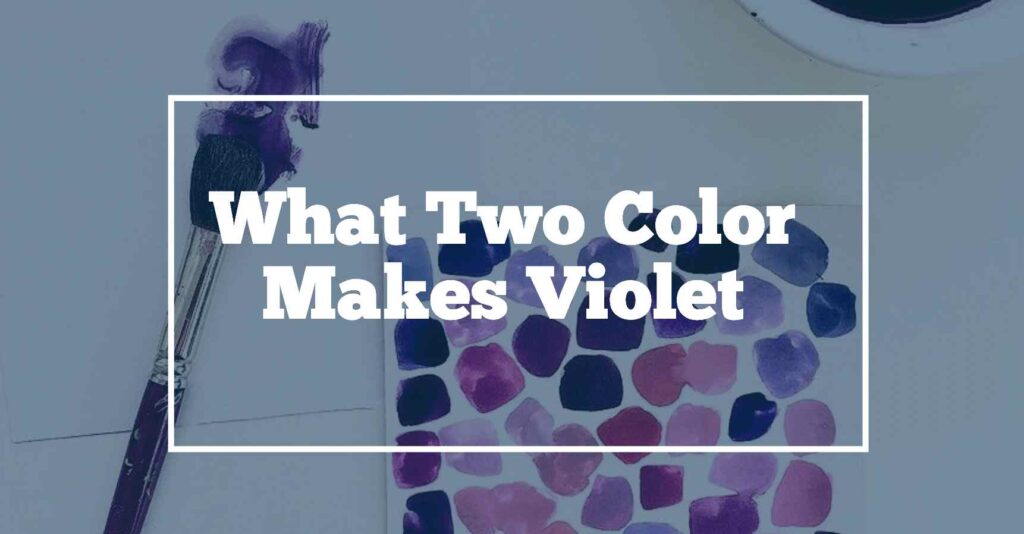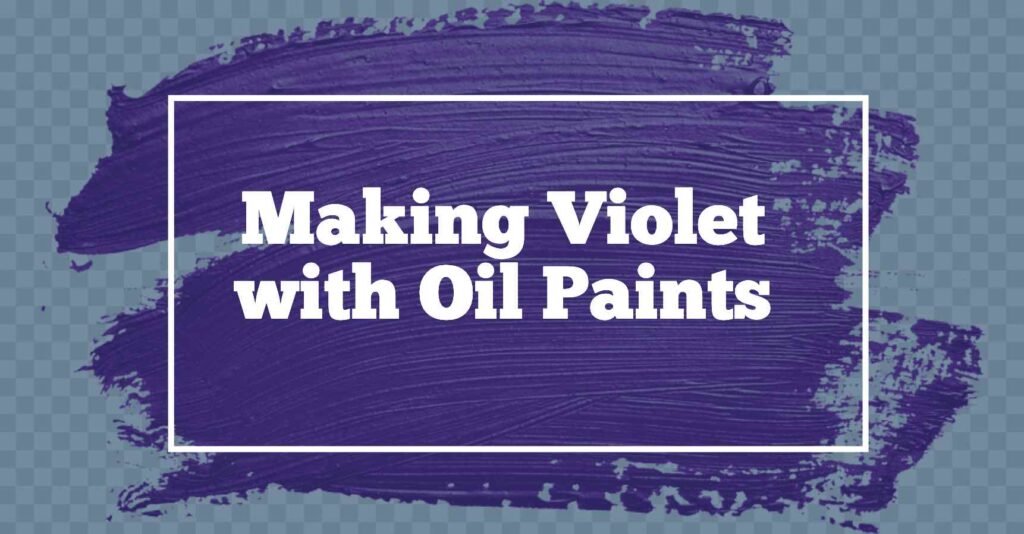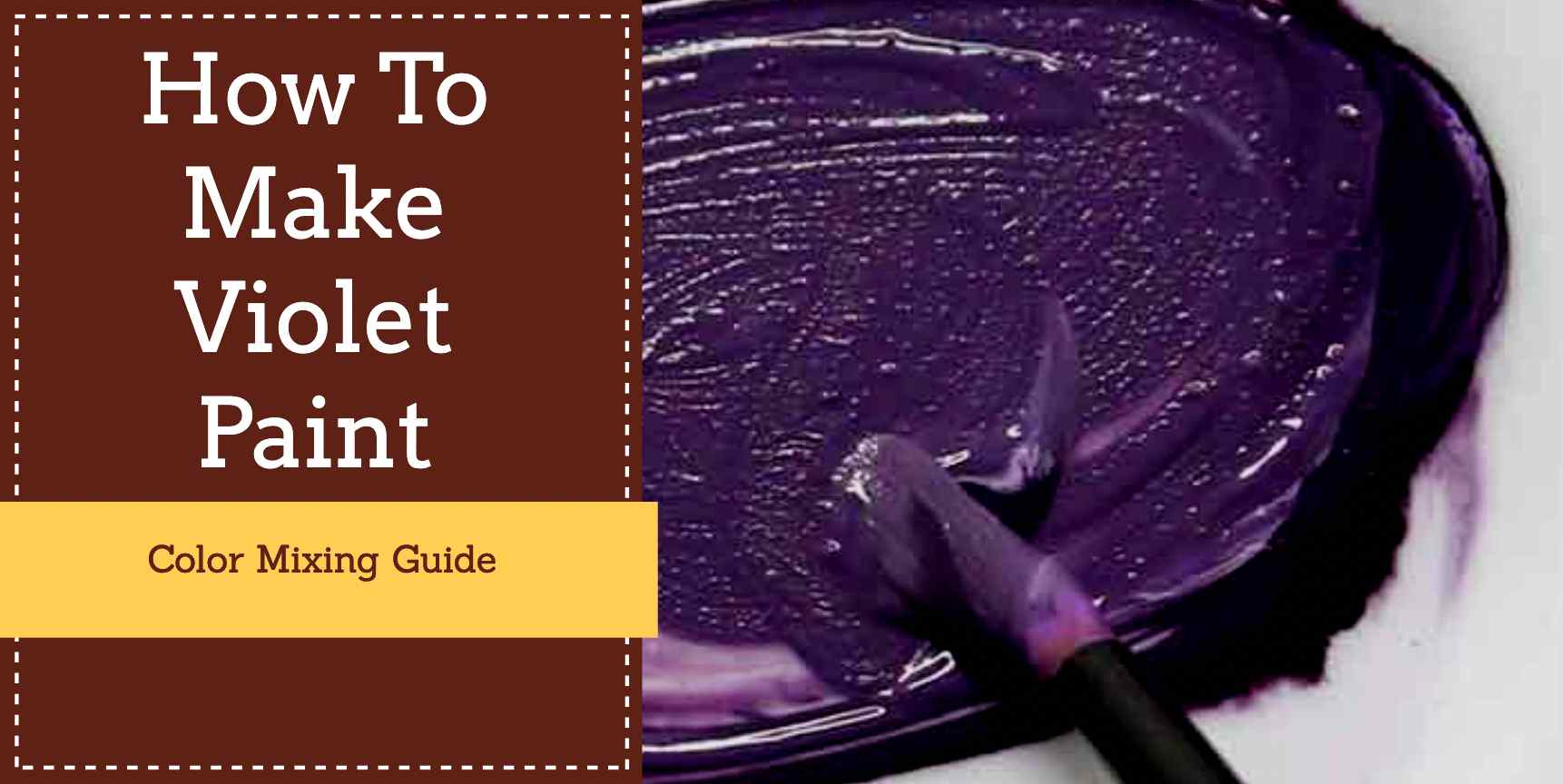Ever wanted to make a beautiful shade of violet paint? Not only you, everyone wants. Many artists, whether beginners or experts love the rich and deep feel of violet. But creating it can be a bit tricky & time taking, especially since there are different types of paints like acrylics, oil paints, and watercolors. Each type of paint behaves differently. In this guide, we’ll go step by step, showing you how to make violet paint in each medium. By the end, you’ll have a clear and easy method to make that perfect shade of violet for your artwork. Let’s start and learn it together!
Also Read: How To Make Purple Paint
What Two Color Makes Violet

Want to make violet? It’s easier than you might think. To get that awesome shade of violet, you just need two basic colors: red and blue. Think like this, red brings warmth and energy, while blue adds coolness and depth. When you mix them together, you get violet! But here’s a thing to keep in mind, the amount of each color you use matters. If you add too much red, you’ll end up with a brighter, more pinkish color. Use more blue, and you’ll get a deeper, almost navy hue. The trick is to play around with the balance until you find the perfect shade of violet for you. So, grab your paints, mix them up, and see the color magic happens. Remember, it’s all about experimenting and finding the right shade at your own home. Have fun and enjoy painting your artwork!
Making Violet Paint at Home
You can easily make violet at your own home! All you need is red and blue paint. Take some blue paint and add a bit of red to it. Mix them together. If it looks too blue, add more red. If it’s too red, add more blue. Keep mixing until you get the violet color you like. It’s fun to see how the colors change as you mix. Try it and make your perfect shade of violet!
Step-by-Step Guide: Making Violet with Acrylic Paints
Hey there, future painting pro! Ready to make some violet using acrylics? Let’s start it down step by step:
1. Preparation: Find a clean, flat surface and lay out your materials. You’ll need blue and red acrylic paints, a mixing palette (or a simple plate works too), and a clean paintbrush or palette knife for mixing.
2. Squeeze Out the Blue: Start by placing a small pinch of blue paint onto your mixing palette. This is our base color for violet.
3. Add the Red: Gently squeeze out a smaller amount of red paint next to the blue. Remember, we can always add more red later, so it’s a good idea to start with less.
4. Begin Mixing: Using your brush or palette knife, begin to blend the blue and red together. Mix until you have a consistent color throughout.
5. Evaluate the Shade: Look at the color. Is it the shade of violet you’re aiming for? If it’s too blue, add a tiny bit more red. If it’s too red, add a smidge of blue.
6. Adjust and Mix: Continue adjusting by adding small amounts of red or blue and mixing thoroughly until you’re satisfied with your violet.
7. Test & Paint: Before using it on your main artwork, test your mixed violet on a scrap piece of paper to see how it looks when applied. If it looks good, you’re ready to paint!
8. Enjoy the Process: Remember, making your own colors is all about experimenting and finding what works best for you. The more you mix, the better you’ll get at creating your perfect shades.
That’s it! Now you’ve got a lovely shade of violet made from acrylic paints.
Step-by-Step Guide: Making Violet with Oil Paints

As we’ve already told you about making violet using acrylics at home. Now comes making violet with oil paints. Here, we’ll let you know about crafting a beautiful violet shade using oil paints. Oil paints offer rich, deep color and texture, making them a favorite for many artists. Let’s master the violet mix together & start making violet at home step by step:
1. Set Up Your Workspace: Due to the nature of oil paints, it’s essential to have a well-ventilated area. Lay down your materials, ensuring you have blue and red oil paints, a mixing palette, and a palette knife. You might also want some linseed oil or a medium to modify the paint consistency if needed.
2. Starting with Blue: On your palette, place a lump of blue oil paint. This will be the foundational color for your violet.
3. Introduce the Red: Beside the blue, add a slightly smaller amount of red oil paint. With oil paints, a little effects a lot, so be careful.
4. Mixing Time: Using your palette knife, gently blend the blue and red together. The palette knife will help maintain the richness of the oil paints and ensure a smooth blend.
5. Assess Your Mix: Take a moment to observe the shade. If your mix is leaning too much towards blue, add a touch more red. If it’s veering on the pink side, add a little more blue.
6. Consistency Check: Oil paints can sometimes be thick. If you find your mixed color too dense, add a tiny drop of linseed oil or your preferred medium, and mix it in.
7. Test Before Applying: Before applying your custom-made violet to your artwork, test the shade on a small corner or a scrap canvas. This gives you a chance to see how it looks and dries.
8. Relish the Experience: The beauty of working with oil paints is the depth and texture they offer. Embrace the process, knowing each mix makes you more adept at creating your desired shades.
And voila! With these steps, you’ve got yourself a captivating shade of violet using oil paints at your own home.
Also Read: How To Make Magenta Paint
Step-by-Step Guide: Making Violet with Acrylic Paints
Acrylic paints are versatile and dry quickly, making them a popular choice for many. Here’s your step-by-step guide to achieving the perfect violet shade using acrylic paints:
1. Prepare Your Workspace: Acrylics dry fast, so have everything at hand. Set out your blue and red acrylic paints, a mixing palette, and a palette knife or brush for blending.
2. Add Blue: Begin by placing a blob of blue acrylic paint onto your palette. This blue will serve as our main color for crafting violet.
3. Add some Red: Next to your blue, squeeze out a smaller portion of red paint. It’s easier to add more red later than to reverse an overly-red mix.
4. Mix Them Together: Take your palette knife or brush and merge the red and blue. Stir until they combine into a unified shade.
5. Check the Color: Hold up! check how’s the shade looking. If it’s too indigo-like, add a smidge more red. If it’s leaning towards magenta, add a pinch more blue.
6. Adjust as Needed: Continue fine-tuning your mix, adding small amounts of either color until you get that perfect shade of violet.
7. Do a Quick Test: Before you go all in, test your violet on a spare piece of paper or canvas. It’s a great way to preview how it’ll look in action.
8. Enjoy the Journey: Remember, part of the fun with acrylics is experimenting. With every mix you make your color-matching skills a more.
There you have it! With these steps, you’re now equipped with a lovely shade of violet crafted with acrylic paints.
FAQs on Crafting Violet in Various Paint Mediums
Q: How do I create violet using acrylic paints?
A: With acrylics, start with a base of blue and then gradually introduce red to the mix. Because acrylics dry quickly, you’ll need to work relatively swiftly. If your mix leans too purplish, add more red, and if it’s too pinkish, add a bit more blue.
Q: What’s the process for mixing violet in oil paints?
A: Oil paints are about patience and blending. Begin with a foundation of blue, and slowly blend in the red. Due to the slow-drying nature of oils, you have the luxury of time on your side. Adjust your shade until you’re satisfied, and you can even use a medium to help with consistency.
Q: How about achieving violet with watercolors?
A: Watercolors are all about mastering the water-to-paint ratio. Start with a slightly wet blue base and gradually introduce your red. The water will naturally help merge the colors. Just remember: too much water can dilute the shade, while too little might not give you a smooth blend.
Q: Can I mix different paint mediums together?
A: While it’s technically possible, it’s generally not advised. Each medium has its unique properties, and mixing them can result in unpredictable outcomes.
Q: Which medium offers the longest-lasting shade of violet?
A: Typically, oil paints are known for their longevity and rich, lasting colors. However, with proper care and preservation methods, acrylics and watercolors can also retain their vibrancy for a long time.
Q: Is it possible to customize my shade of violet?
A: Absolutely! Art is all about personal expression. Feel free to tweak, adjust, and remix your colors until you achieve the exact shade of violet that resonates with you. The key is to experiment and have fun with the process!
Q: I’ve heard about ‘warm’ and ‘cool’ violets. How do I achieve these tones?
A: The temperature of your violet shade depends on the specific reds and blues you choose. For a ‘warm’ violet in any medium, use a red that leans more towards orange, like a cadmium red. For a ‘cool’ violet, opt for a blue with a touch of green, like cerulean or turquoise, and pair it with a cooler red, such as alizarin crimson.
Q: Can I use commercial paint extenders to increase the volume of my mixed violet paint?
A: Yes, paint extenders or mediums can be added to increase the volume without compromising the color intensity. However, always read the manufacturer’s instructions. For acrylics, an acrylic medium would be suitable; for oil, linseed oil or another appropriate oil medium would work. With watercolors, simply increasing the water can dilute the color, so use extenders specifically designed for watercolors if you need more volume.
Q: I want to store my mixed violet paint. How should I do it to ensure its longevity?
A: For acrylics, transfer your mixed paint to an airtight container; this will prevent it from drying out. For oil paints, a palette cup with a tight-sealing lid works wonders. If you’ve mixed a large batch, you might even consider using a clean, sealable tube. Watercolors can be left to dry on the palette and re-wet when needed, but for a liquid mix, an airtight container is again your best bet. Always store paints away from direct sunlight and in a cool, dry place to ensure they remain in the best condition.
Conclusion:
Making violet paint isn’t too difficult, whether you’re using acrylics, oil paints or watercolors. Each type of paint acts a bit differently, but the basic idea is mixing red and blue together. With acrylics, mix quickly because they dry fast. For oil paints, take your time as they dry slowly. With watercolors, watch the water amount so the color spreads well. Whatever you choose, remember: it’s about trying, testing, and seeing what works best for you. Keep practicing, and soon you’ll get the perfect shade of violet you’re aiming for. Happy painting!

